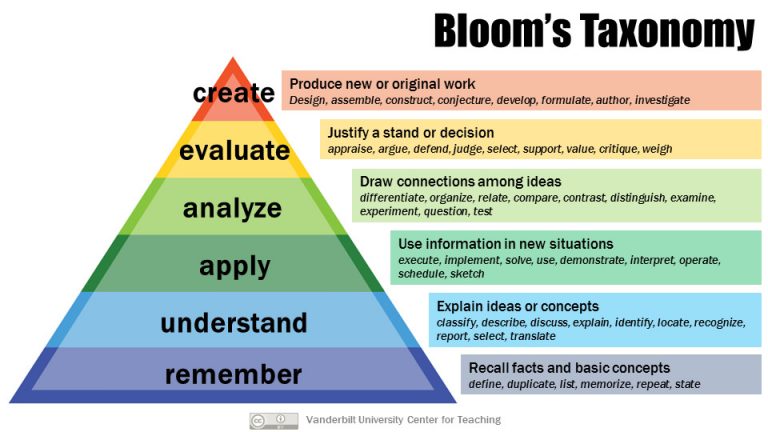Remember… Understand… Apply… Analyse… Evaluate… Create
These are the 6 levels of knowledge in Bloom’s Taxonomy.
Bloom’s Taxonomy helps you as a teacher to address the question: “What should my learners know or be able to do at the end of this year?”
Bloom’s Taxonomy was developed by Benjamin Bloom, an educational psychologist at the University of Chicago, in 1956. It was developed to provide a common language for teachers; this would enable them to discuss and exchange learning and assessment methods.
Through using Bloom’s Taxonomy you can define, and distinguish between, different levels of cognition – thinking, learning and understanding – among your learners.

As you will undoubtedly remember from when you were training as a teacher, Bloom’s Taxonomy depicts the process of learning as a pyramid.
Learning at the higher levels is dependent on having attained the prerequisite knowledge and skills at the lower levels i.e. it encourages higher-order thought by a process of building up from the lower level cognitive skills. Each level above depends on the one below.
This is how it works:
Level 1: Remember
Learners recognise and recall / remember / retrieve basic facts / knowledge, concepts, processes, patterns, structures, and settings.
Example: Remembering a mathematical formula, listing all the countries in a specific geographic area, reciting a poem, compiling a timeline.
Level 2: Understand
Learners interpret / decode / summarise the meaning and significance behind concepts, facts and ideas – conveyed orally or in writing or through graphics – and communicate / explain this to others.
Example: Summarising the main ideas or plot of a short story / novel, preparing a flow chart, writing a summary of an event.
Level 3: Apply
Learners use / implement the knowledge and skills they have developed, in new contexts or situations.
Example: Drawing up a budget, analysing a character in a novel / short story, using a formula to solve a problem, designing a market strategy for a product.
Level 4: Analyse
Learners break down concepts into their different parts, determining how the parts are connected or relate to each other, as well as to an overall structure. Learners are able to differentiate and organise.
Example: Distinguishing between fact and opinion in an article or newspaper, figuring out how a specific machine works or why it is not working, explaining how democracy works.
Level 5: Evaluate
Learners use the knowledge and skills they’ve gained to state opinions, make judgements, justify beliefs and appraise situations. They do this by cross-checking and using criteria.
Example: Making a judgement on an ethical dilemma, interpreting why a specific law is significant, taking part in a debate on an issue of special interest.
Level 6: Create
Learners formulate their own solutions to problems and they create original work.
Example: Writing a poem, developing a business plan, thinking of methods to minimise the effects of greenhouse gases on the earth’s climate.